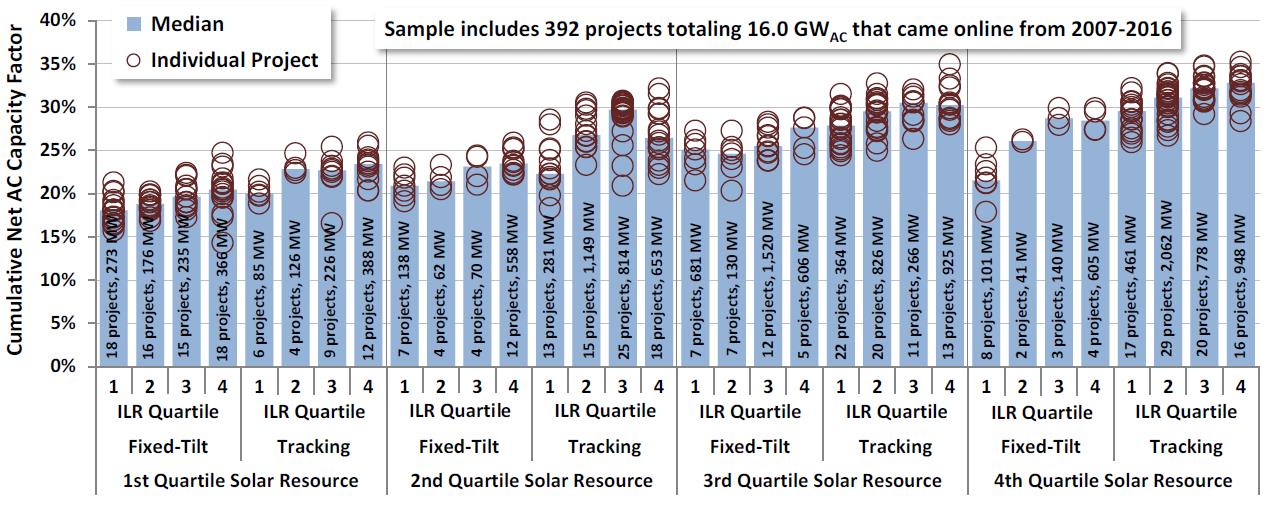Utility-Scale PV
Capacity Factor
Definition: The capacity factor represents the expected annual average energy production divided by the annual energy production, assuming the plant operates at rated capacity for every hour of the year. It is intended to represent a long-term average over the lifetime of the plant; it does not represent interannual variation in energy production. Future year estimates represent the estimated annual average capacity factor over the technical lifetime of a new plant installed in a given year.
PV system inverters, which convert DC energy/power to AC energy/power, have AC capacity ratings; therefore, the capacity of a PV system is rated in MWAC, or the aggregation of all inverters' rated capacities, or MWDC, or the aggregation of all modules' rated capacities. Other technologies' capacity factors are represented exclusively in AC units; however, in previous years of the ATB, PV pricing is represented in $/kWDC. In the 2020 ATB, we represent utility-scale PV (though not commercial PV or residential PV) in $/KWAC; for this reason, values in this year's report are not directly comparable to previous years of the ATB without adjusting previous versions from WDC to WAC.
The capacity factor is influenced by the hourly solar profile, technology (e.g., thin-film or crystalline silicon), the bifaciality of the module, axis type (i.e., none, one, or two), shading, expected downtime, and inverter losses to transform from DC to AC power. The DC-to-AC ratio is a design choice that influences the capacity factor. PV plant capacity factor incorporates an assumed degradation rate of 0.7%/yr (Feldman et al. Forthcoming) in the annual average calculation. R&D could increase energy yield through bifaciality, better soil removal, improved cell temperature, lower system losses, O&M practices that improve uptime, and lower degradation rates of PV plant capacity factor; future projections assume energy yield gains of 0% to 27% depending on the location and scenario.
Base Year: Click here and select Tech Detail = All to add filters to the initial figure on this page to display a range of capacity factors based on variation in solar resource in the contiguous United States. The range of the Base Year estimates illustrate the effect of locating a utility-scale PV plant in places with lower or higher solar irradiance. These five values use specific locations as examples of high (Daggett, California), high-mid (Los Angeles, California), mid (Kansas City, Missouri), low-mid (Chicago, Illinois), and low (Seattle, Washington) resource areas in the United States as implemented in the System Advisor Model using PV system characteristics from Feldman et al. (Forthcoming).
Because we switched from using DC ratings to using AC ratings, and because we incorporated technology trends in energy yield gain, capacity factors in the 2020 ATB are higher than those reported in previous ATBs. In the 2020 ATB, we use capacity factors of 21.8%, 25.2%, 27.2%, 31.9%, and 35.1% in the Base Year. The 2020 ATB capacity factor assumptions are based on ILR = 1.34. The figure below shows historical data for capacity factor as a function of ILR.
Base Year: At the end of 2018, the cumulative capacity-weighted average AC capacity factor for all U.S. projects installed at the time was 25.0% (including fixed-tilt systems), but individual project-level capacity factors exhibited a wide range (12.1%–34.8%).

Over time, PV plant output is reduced. This degradation (at 0.7%/yr) is accounted for in ATB estimates of capacity factor. The 2020 ATB capacity factor estimates represent estimated annual average energy production over a 30-year lifetime.
These AC capacity factors are for a one-axis tracking system with a DC-to-AC ratio of 1.34, and therefore is not representative of the lower capacity factors reported by fixed-tilt systems.
Future Years: Projections of capacity factors for plants installed in future years increase over time because of an increase in energy yield from the module, reduced system losses, and a straight-line reduction in PV plant capacity degradation rates from 0.7%/yr that reach 0.5%/yr, and 0.2%/yr by 2030 for the moderate and advanced technology innovation scenarios respectively. The Conservative Scenario assumes no improvement in degradation rates through 2030. The following table summarizes the difference in average capacity factor in 2030 caused by these changes in the technology innovation scenarios. Similar to our CAPEX assumptions, we assume each scenario's 2050 capacity factor is the equivalent of the 2030 capacity factor of the scenario but one degree more aggressive, with a straight-line change in price in the intermediate years between 2030 and 2050. The table below summarizes capacity factors for each ATB scenario by resource class.
Seattle, WA | Chicago, IL | Kansas City, MO | Los Angeles, CA | Daggett, CA | |
Advanced Scenario | 25.9% | 29.7% | 31.7% | 36.1% | 39.5% |
Moderate Scenario | 23.7% | 27.2% | 29.3% | 33.9% | 37.2% |
Conservative Scenario | 21.8% | 25.2% | 27.2% | 31.9% | 35.1% |
We also developed and modeled a scenario one degree more aggressive than the Advanced Scenario to estimate its 2050 capacity factor. The 2050 Advances Scenario assumes: 18%-27% energy gain, depending on location, through a 30% energy yield gain at the module and lower system losses; and a 0.2%/year degradation rate. This is achieved through bifaciality, better tracking, soil removal, improved cell temperature, and improved O&M uptime.
References
The following references are specific to this page; for all references in this ATB, see References.
Bolinger, Mark, & Seel, Joachim. (2018). Utility-Scale Solar: An Empirical Trends in Project Technology, Cost, Performance, and PPA Pricing in the United States (2018 Edition). Lawrence Berkeley National Laboratory. https://emp.lbl.gov/sites/default/files/lbnl_utility_scale_solar_2018_edition_report.pdf
Feldman, David, Vignesh Ramasamy, Ran Fu, Ashwin Ramdas, Jal Desai, and Robert Margolis. (Forthcoming). U.S. Solar Photovoltaic System and Energy Storage Cost Benchmark: Q1 2020. Golden, CO: National Renewable Energy Laboratory.
Developed with funding from the U.S. Department of Energy’s Office of Energy Efficiency and Renewable Energy.